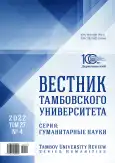The use of famous paintings as means of cognitive visualization in teaching language
- Authors: Zueva V.V.1
-
Affiliations:
- Moscow State Institute of International Relations (University) of the Ministry of Foreign Affairs of the Russian Federation
- Issue: Vol 27, No 4 (2022)
- Pages: 952-960
- Section: THEORY AND METHODS OF FOREIGN LANGUAGE TEACHING
- URL: https://journal-vniispk.ru/1810-0201/article/view/298269
- DOI: https://doi.org/10.20310/1810-0201-2022-27-4-952-960
- ID: 298269
Cite item
Full Text
Abstract
The relevance of the research topic is due to close attention of scientific and pedagogical public to the issues of cognitive education. Over the past years there has been sustainable interest to various methods of cognitive visualization and a search for new forms of work for the formation of cognitive interest and development of reflective mental activity. Purpose: to substantiate the effectiveness of the use of famous paintings as cognitive visual material to enhance students’ learning and cognitive activity at English classes and to present the types of tasks with them. Research methods: research methods are based on an analytical review of scientific sources on issues of cognitive education, the use of visual aids in the educational process and generalization of personal pedagogical experience of using the proposed tasks at English classes in the 1st year of the Faculty of Linguistics and Intercultural Communication of the Odintsovo branch of the Moscow State Institute of International Relations (University) of Ministry of Foreign Affairs of Russian Federation. Results: the article presents examples of tasks which generate interest, stimulate cognitive activity and contribute to the development of all components of communicative competence. It is concluded that within the framework of the communicative and cognitive approach, the use of paintings as visual visualization has great potential in the field of motivation, creation of a positive attitude towards learning and contributes to the effective solution of several educational and pedagogical tasks.
About the authors
V. V. Zueva
Moscow State Institute of International Relations (University) of the Ministry of Foreign Affairs of the Russian Federation
Author for correspondence.
Email: v.zueva@odin.mgimo.ru
ORCID iD: 0000-0003-0770-7343
Candidate of Philology, Associate Professor of the English Language Department
76 Vernadskogo Ave., Moscow 119454, Russian FederationReferences
- Akhmetova L.V. Kognitivnaya sfera lichnosti – psikhologicheskaya osnova obucheniya [The cognitive sphere of personality: psychological basis of learning]. Vestnik Tomskogo gosudarstvennogo pedagogicheskogo universiteta – Tomsk State Pedagogical University Bulletin, 2009, no. 9 (87), pp. 109-115. (In Russian).
- Ushinskiy K.D. Sobraniye sochineniy. T. 10. Materialy k tretyemu tomu «Pedagogicheskoy antropologii» [Col-lected works. Vol. 10. Materials for the third volume of “Pedagogical Anthropology”]. Moscow, Leningrad, Academy of Pedagogical Sciences Publ., 1950, 665 p. (In Russian).
- Akhmetova L.V. Metody kognitivnogo obucheniya: psikhologo-didakticheskiy podkhod [Cognitive education methods: psychological and didactic approach]. Vestnik Tomskogo gosudarstvennogo pedagogicheskogo universiteta – Tomsk State Pedagogical University Bulletin, 2009, no. 7 (85), pp. 48-52. (In Russian).
- Nurekeshova G., Ashirova B., Ordabayev C. Using Communicative and Linguo-cognitive activities in teaching foreign languages. Aktual’nyye nauchnyye issledovaniya v sovremennom mire – Actual Scientific Research in the Modern World, 2021, no. 9-4 (77), pp. 35-41.
- Man’ko N.N. Kognitivnaya vizualizatsiya didakticheskikh ob”yektov v aktivizatsii uchebnoy deyatel’nosti [Cognitive visualization of didactic objects in stirring up educational activity]. Izvestiya Altayskogo gosu-darstvennogo universiteta – News of Altai State University, 2009, no. 2 (62), pp. 22-28. (In Russian).
- Syrina T.A. Kognitivnaya vizualizatsiya: sushchnost’ ponyatiya i ego rol’ v obuchenii yazyku [Cognitive visua-lization: the essence of the concept and its role in language teaching]. Vestnik Tomskogo gosudarstvennogo pe-dagogicheskogo universiteta – Tomsk State Pedagogical University Bulletin, 2016, no. 7 (172), pp. 81-85. (In Russian).
- Sarycheva L.V., Syrina T.A. Intellektual’naya viktorina – effektivnyyy metod razvitiya poznavatel’nogo interesa izuchayushchikh inostrannyy yazyk [Intellectual quiz as an effective method of cognitive interest development among foreign language learners]. Mir nauki. Pedagogika i psikhologiya – The World of Science. Pedagogy and Psychology, 2019, vol. 7, no. 1, art. 12. (In Russian).
- Kholod N.I., Nikitina I.Y. Viktorina kak sredstvo aktivizatsii uchebno-poznavatel’noyy deyatel’nosti studentov na zanyatiyakh po inostrannomu yazyku v vuze [Quiz as means of activizing students’ educational cognitive activity at foreign language classes in higher education institution]. Yaroslavskiy pedagogicheskiy vestnik – Ya-roslavl Pedagogical Bulletin, 2017, no. 2, pp. 137-141. (In Russian).
- Dmitriyeva D.D. Ispol’zovaniye proizvedeniy iskusstva v protsesse obucheniya inostrannykh studentov russko-mu yazyku [Use of art works in the process of teaching foreign students Russian language]. Baltiyskiy gumani-tarnyy zhurnal – Baltic Humanitarian Journal, 2020, no. 4 (33), pp. 62-64. https://doi.org/ 10.26140/bgz3-2020-0904-0017. (In Russian).
- Karimbekov S.A. Ispol’zovaniye proizvedeniy iskusstva pri obuchenii angliyskomu yazyku [The use of works of art in teaching English]. Inostrannyye yazyki v shkole – Foreign Languages in School, 2009, no. 5, pp. 24-28. (In Russian).
- Magomedova A.K. Ispol’zovaniye materialov iskusstva na uroke angliyskogo yazyka v starshikh klassakh srednei shkoly [The use of art materials in the English class in high school]. Molodoy uchenyy – Young Scientist, 2019, no. 43 (281), pp. 255-256. (In Russian).
- Filippova N.V., Prokopenko G.I. Ispol’zovaniye proizvedeniy zhivopisi dlya razvitiya rechemyslitel’noy deya-tel’nosti uchashchikhsya starshikh klassov na urokakh inostrannogo yazyka [The use of paintings for the devel-opment of verbal-cogitative activity of high school students during foreign language lessons]. Dostizheniya nau-ki i obrazovaniya – Achievements in Science and Education, 2019, no. 7 (48), pp. 41-43. (In Russian).
Supplementary files









